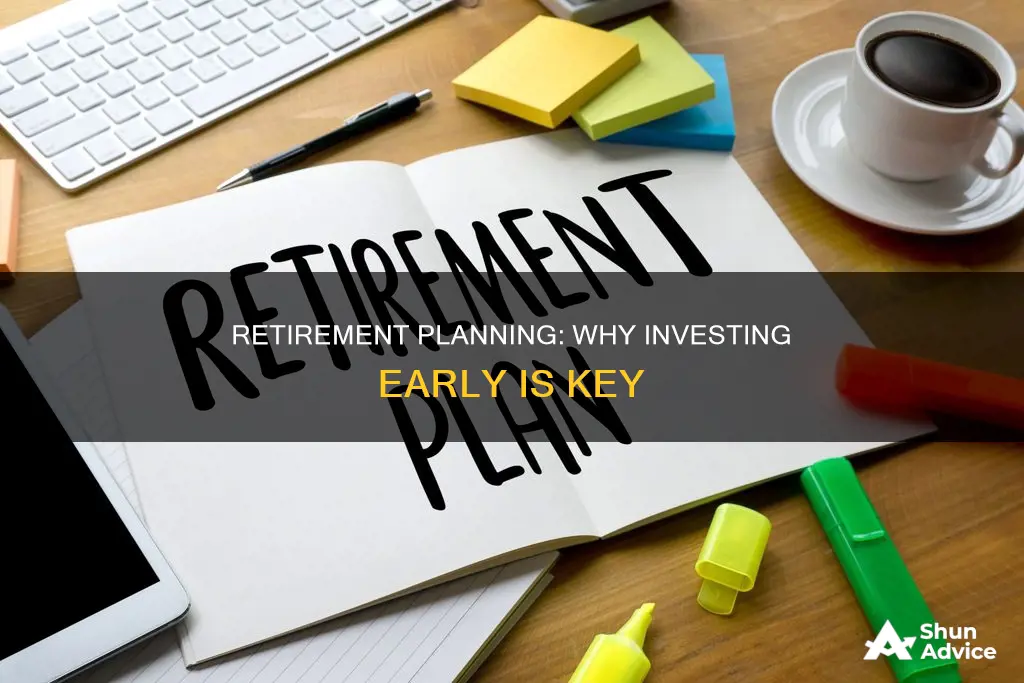
Investing for retirement is a crucial aspect of financial planning, and it's never too early to start. The earlier you begin, the more time your investments have to grow and compound, potentially resulting in a more comfortable retirement. There are various investment options available, each with its own risks and rewards. It's essential to understand your risk tolerance, time horizon, and financial goals when deciding where to put your money.
When considering retirement investments, it's common to choose between tax-advantaged accounts, such as employer-sponsored plans (401(k), 403(b)) or individual retirement accounts (IRAs), and regular investment accounts without tax advantages. Tax-advantaged accounts offer significant benefits, allowing your money to grow tax-free or tax-deferred until retirement. However, they usually have annual contribution limits. Regular investment accounts provide more flexibility but lack the tax benefits.
Within these accounts, you can invest in a variety of assets, including stocks, bonds, mutual funds, exchange-traded funds (ETFs), and annuities. Diversification is essential to manage risk and maximise returns. This involves spreading your investments across different asset classes, industries, company sizes, and geographic regions.
Additionally, your investment strategy may change as you get older. Generally, younger investors can afford to take on more risk, while older investors may opt for more conservative approaches to protect their principal and generate stable income.
It's always a good idea to consult with a financial advisor to determine the best investment strategy for your retirement goals and risk tolerance. They can provide personalised advice and help you navigate the complexities of investing for retirement.
| Characteristics | Values |
|---|---|
| When to start investing for retirement | As soon as possible |
| How much to invest for retirement | 10% to 15% of your income |
| Where to put your retirement money | A retirement account offered by your employer (e.g. 401(k), 403(b), 457(b), pension plans) or your own tax-advantaged retirement account (e.g. IRA, Roth IRA) |
| Investment options | Stocks, bonds, cash, mutual funds, index funds, ETFs, annuities, rental property, dividend-paying stocks, REITs, QLACs |
| Investment strategy | Determine your risk tolerance, age, and cash balance to decide how aggressive you want to be with your portfolio |
What You'll Learn

How much money do I need to invest for retirement?
The amount of money you need to invest for retirement depends on several factors, including your current income, age, lifestyle, and retirement plans.
Retirement experts recommend saving 10 times your pre-retirement salary and planning to live on 70%-80% of your pre-retirement annual income. This means that if you make $100,000 annually at retirement, you should aim for at least $70,000-$80,000 per year to maintain your current lifestyle.
However, this amount can be adjusted based on other sources of income, such as Social Security, pensions, and part-time employment, as well as your health and desired retirement lifestyle. For example, if you plan to travel frequently during retirement, you may want to aim for a higher percentage of your pre-retirement income. On the other hand, if you plan to downsize your living situation or have already paid off your mortgage, you may be able to live comfortably on less.
To determine how much you need to invest to generate your desired retirement income, you can use the 4% rule. This rule states that you can withdraw 4% of your retirement savings in the first year of retirement, adjusted for inflation in subsequent years.
For example, if you want a retirement income of $80,000, you would need a retirement nest egg of about $2 million ($80,000 / 0.04). This assumes a 5% return on investments, no additional income sources, and a similar lifestyle to the one you have before retirement.
Retirement Savings by Age
The amount you should save for retirement also depends on your age. Here are some benchmarks to help you stay on track:
- By age 35, aim to save one to one-and-a-half times your current salary.
- By age 40, aim to save three times your salary.
- By age 50, aim to save three-and-a-half to six times your salary.
- By age 60, aim to save six to 11 times your salary.
- By age 67, aim to save 10 times your salary.
These benchmarks are based on saving 15% of your gross salary annually, including any employer contributions, starting in your 20s. However, another formula suggests saving 25% of your gross salary each year, starting in your 20s, which would allow you to accumulate your full annual salary by age 30.
Retirement Calculators
Online retirement calculators can be a helpful tool to determine your retirement savings goals. They can help you understand how changing savings and withdrawal rates can impact your retirement nest egg. It's important to note that these calculators use different assumptions and methods, so it's recommended to use multiple calculators and consult a financial advisor to tailor a retirement plan to your specific situation.
REITs: Invest Now or Later?
You may want to see also

How do I choose the right investments?
Choosing the right investments for your retirement is critical to getting the most out of your savings. Here are some tips to help you make the right choices:
- Understand your options: Familiarize yourself with the different types of retirement accounts and investments available, such as 401(k)s, IRAs, mutual funds, stocks, bonds, and ETFs. Each has its own advantages, tax implications, and risk profile.
- Start early: The power of compounding means that the earlier you start investing, the more your money will grow over time. Starting early also gives you more time to recover from losses and take on higher-risk/higher-reward investments.
- Assess your risk tolerance: Consider your age, risk tolerance, and investment horizon when deciding how to allocate your assets. Younger investors can generally afford to take on more risk, while older investors may want to shift towards more conservative investments.
- Diversify your portfolio: Diversification helps to minimize risk and maximize returns. Spread your investments across different asset classes, industries, company sizes, and geographic regions.
- Keep costs low: Avoid funds with high fees and expenses, as they can eat into your investment returns over time. Look for low-cost index funds or ETFs, and consider the expense ratios of the funds you choose.
- Monitor and rebalance: Regularly review the performance of your investments and adjust your portfolio as needed to maintain your desired asset allocation. This may involve selling some investments that have done well and buying others that may be undervalued.
- Get professional help: If you're unsure about how to choose the right investments, consider seeking advice from a financial advisor or a robo-advisor, which uses computer models to provide investment recommendations.
Utilities: Invest or Avoid?
You may want to see also

What are the best retirement accounts?
Retirement accounts are specialised investment accounts designed to help individuals fund their retirement. There are many different types of retirement accounts available, each with its own unique benefits. Here are some of the best retirement accounts to consider:
- 401(k) Plans: These are tax-advantaged retirement accounts sponsored by employers. Employees can contribute a portion of their paycheck to the account, and employers often match these contributions. There are two types: Traditional 401(k) plans, which are funded by pre-tax income, and Roth 401(k) plans, which are funded by after-tax income, allowing tax-free withdrawals during retirement.
- Individual Retirement Accounts (IRAs): IRAs are tax-advantaged accounts available to anyone with earned income, making them a great option for self-employed workers. There are two main types: Traditional IRAs, which are tax-deferred, and Roth IRAs, which are funded by after-tax income, allowing tax-free withdrawals.
- 403(b) and 457(b) Plans: These are similar to 401(k) plans but are offered to employees of public schools, colleges, non-profits, churches, and government agencies. They also have Traditional and Roth versions available.
- Employee Stock Ownership Plans (ESOPs): ESOPs are profit-sharing retirement benefits that give employees access to shares of their employer's stock. They are tax-advantaged for both the employer and employee.
- SIMPLE and SEP IRAs: These are retirement options geared towards small business owners and their employees. SIMPLE IRAs allow employees to have retirement contributions deducted from their paychecks and deposited into a tax-deferred savings account, with employer matching. SEP IRAs allow employers to contribute to retirement accounts for themselves and their employees, with higher contribution limits than traditional IRAs.
- Traditional Pensions: These are fully funded by employers and provide a fixed monthly benefit to retirees. However, they are becoming less common, with fewer companies offering them.
- Guaranteed Income Annuities (GIAs): Individuals can purchase these annuities to create their own pensions. They can be bought on a tax-deferred basis or within an IRA, offering tax advantages.
- The Federal Thrift Savings Plan (TSP): The TSP is similar to a 401(k) plan but is only available to government workers and members of the uniformed services. It offers low-cost investment options and federal employees can receive employer contributions.
- Cash-Balance Plans: These are a type of defined benefit plan that promises a certain hypothetical account balance based on contribution and investment credits. They provide more certainty about the benefit amount compared to traditional pensions.
- Nonqualified Deferred Compensation Plans (NQDCs): These plans are typically only offered to top executives and allow for tax-deferred savings, but they don't offer the same security as other retirement plans.
Rich People's Investment Strategies
You may want to see also

How do I protect my savings from financial exploitation?
Investing in retirement is a great way to ensure your savings last through your non-working years. However, it's important to be aware of financial exploitation, which can take many forms and be committed by strangers or even those closest to you. Here are some ways to protect your savings from financial exploitation:
- Recognize common scams: Be aware of scams such as lottery and sweepstakes, IRS/Social Security scams, home repair scams, charitable giving scams, sweetheart scams, telemarketing scams, utility/alarm service scams, grandparent scams, pension and retirement scams, investment schemes, internet phishing, identity theft, and Medicare scams. These scams often involve unrealistic returns, requests for personal information, or threats.
- Maintain control of your finances: Keep your financial information private and secure. Be cautious when sharing financial information with others, and avoid giving anyone access to your accounts. Frequently review your bank statements and report any irregularities.
- Be cautious in relationships: Take things slow when building new relationships, especially if someone seems unusually interested in your finances or offers to manage your money. Be wary of anyone who tries to control or undermine you. Maintain friendships with people of all ages and seek support if you feel vulnerable.
- Protect your personal information: Shred bank statements, old credit and debit cards, and any other documents containing personal information. Review your credit report annually and monitor your credit score for any unusual activity.
- Work with trusted professionals: Establish relationships with bank personnel and seek their advice when reviewing financial offers. Consult with a financial advisor or attorney to help you make informed decisions and protect your assets.
- Plan ahead: Determine in advance who you would trust to handle your finances if you are unable to do so in the future. Consider setting up a Power of Attorney to name a trusted individual to manage your finances if needed.
- Be vigilant: Stay informed about new scams and fraudulent activities. Keep up-to-date with technology and financial tools to protect your personal information. Report any suspicious activities to the proper authorities.
By following these steps, you can help protect your savings from financial exploitation and ensure your retirement investments are secure.
Investing to Own: Strategies for Paying Off Your Home
You may want to see also

How do I set up my withdrawals?
Setting up your retirement withdrawals is a crucial step in ensuring your savings last throughout your retirement. Here are the steps to help you set up your withdrawals effectively:
Set up a money market account:
Consider opening a money market account to manage your expenses efficiently. This way, you can transfer a year's worth of withdrawals to this account and then move them to your bank account in monthly instalments. A money market account helps protect your investments from frequent market swings and gives you easy access to your money without directly linking it to your investments.
Take Required Minimum Distributions (RMDs):
Once you turn 73, you are required by law to start taking RMDs from your retirement accounts like 401(k)s and IRAs. These distributions are mandatory and subject to steep IRS penalties if not taken on time. The RMD amount is calculated based on your age, life expectancy, and year-end account balance. You can set up automatic RMDs with your retirement plan administrator to ensure you stay compliant.
Direct dividends and capital gains to your money market account:
Instead of reinvesting your earnings, consider directing them to your money market fund. This way, you can avoid paying taxes multiple times on the same gains. By sending your dividends and capital gains to your money market account, you simplify your tax obligations.
Withdraw from your accounts in a strategic order:
The order in which you withdraw from your various accounts can significantly impact your tax obligations. Here is a suggested order:
- Taxable accounts: Withdraw from these accounts first to utilise their benefits for as long as possible. Remember to offset your capital gains with losses to minimise taxes.
- Tax-deferred accounts: After exhausting your taxable accounts, move on to tax-deferred accounts like traditional 401(k)s and IRAs.
- Tax-free accounts: Finally, tap into your tax-free accounts, such as Roth 401(k)s and Roth IRAs. Withdrawals from these accounts are entirely tax-free after age 59½, and you can even include them in your estate plan.
Consider a withdrawal strategy:
To make your retirement savings last, consider adopting a withdrawal strategy that suits your needs and risk tolerance. Here are some common strategies:
- Fixed-dollar withdrawals: Withdraw a fixed amount annually, reassessing at regular intervals. This provides predictable income but may not account for inflation.
- Fixed-percentage withdrawals: Withdraw a set percentage of your portfolio annually, allowing your withdrawal amount to vary based on the underlying value of your portfolio.
- Systematic withdrawals: Only withdraw the income generated by your investments, such as dividends or interest, leaving your principal invested.
- "Buckets" strategy: Divide your assets into separate "buckets" or accounts. One bucket may hold cash or fixed-income investments for near-term income, while another may focus on growth investments for the long term.
Remember, it's essential to carefully manage your withdrawals to ensure your retirement savings last throughout your golden years.
Where to Invest: Industries to Back Now
You may want to see also







